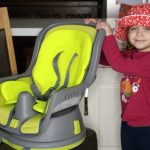
You never quite realise just how dangerous the average home is to a baby or a young child until you have one of your own. When they don’t yet understand that they shouldn’t stick their fingers into power sockets or that they shouldn’t climb inside the fridge, it’s up to parents to make sure that the choice is taken away by babyproofing every potential baby hazard in their home before their baby arrives.
Different parts of the house should be babyproofed at different times – for instance, you don’t need to bother installing stairgates as soon as the baby is born because he won’t start crawling for about eight months, and even then he’ll be closely supervised whenever he’s on the move. At a time when finances could be tight (babies are many things but cheap isn’t one of them!), try not to go overboard on babyproofing measures until you really have to.
The list below is split into three sections highlighting the specific point at which different babyproofing measures need to be taken.
When your baby is born
A new-born baby shouldn’t cause you too many problems because they’re not mobile yet. Nevertheless, there are babyproofing products you should invest in at this point.
- Put a non-slip mat in the bath – trying to keep a wet baby in one place is like trying to hold onto a bar of soap, so a non-slip base will make things significantly easier at bath-time.
- Install a rear-facing car seat – this is a legal requirement anyway, so there’s no reason for you not to do it.
- Put a cat net over the top of the cot – if you have a cat, this will prevent it from jumping into the cot while your baby is asleep.
- Buy a sturdy, wide-based high chair – even if the chair is completely safe and secure and nigh-on impossible to fall out of, it’s still not recommended to leave your baby alone in it, even for a few seconds.
When your baby begins to crawl
This is when you need to be on your toes. Not only will the baby be able to crawl around, but he will also be able to pull themselves up using ledges like tables and chairs. This increases the amount of risk that you have to negate by babyproofing every hazardous area of your home.
- Cover electrical power sockets – it’s never a good idea to allow little fingers access to the source of an electrical current.
- Cover bath taps – in addition to preventing the baby from being able to turn them on, the hot tap can cause burns after water has flowed through it.
- Fit an oven door guard.
- Keep all hazardous items in a high cupboard or other inaccessible area.
- Use doorstops or door latches to protect fingers.
- Push furniture against the wall and hide electrical cables behind it – if the furniture is in the middle of the room with ample space behind it, there may be no need to move it, but cables should still be hidden or placed out of reach.
- Use window guards on windows – at this point, you only need to install window guards on the windows at ground or low, reachable levels.
- Install safety gates at the top and bottom of stairs.
- Install a fireguard – this should be in place even when the fire is not lit.
- Attach corner and edge guards to furniture and appliances – these can be sharp and babies don’t tend to look where they’re going.
- Install pool fencing – if you have a pool, remove the risk of drowning by fencing it off.
- Install toilet seat latches.
- Install drawer latches.
When your baby begins to walk
Once your baby can walk and balance himself, there are various practical things that you should do to prevent accidents, such as turning pans on top of a stove so that the handles face inwards. In terms of adding new babyproofing products to your home, everything you need should have already been installed. If it hasn’t, install it now in addition to taking the following steps:
- Move blind cords and other hanging cords out of reach.
- Move all free-standing shelf items out of reach.
You can never be too careful when it comes to your baby’s safety – double and triple-check everything around your home to ensure that it doesn’t present a safety hazard. If in doubt, do something about it!







5 thoughts on “Guide to babyproofing your home”
I don’t need to apply these tips to my home yet but they are really helpful and informative. 🙂
Keep them in mind, they might come in useful one day!
Some great advice, one comment I would add though. I recently was talking to one of the staff at our childrens centre and she showed me the problem with the older style soft plastic socket covers that I still see on sale in places. First a little meandering though, English sockets have shutters in them so that the live and neutral pins are protected until you insert an earth pin (Part of the reason an earth pin is longer). In several situations it had been found that children had managed to pull the socket cover off, turn it around and push it back into the earth pin and so expose the live and earth that otherwise would have been protected. If you are fitting the socket covers then it is better to make sure they are solid ones, preferably with a key.
Wow Kevin, that is interesting advice. I’d never heard of that before. Thanks for bringing it to my attention.
No problem, I find it amazing how much there is to learn that I had never even thought about before having a child.